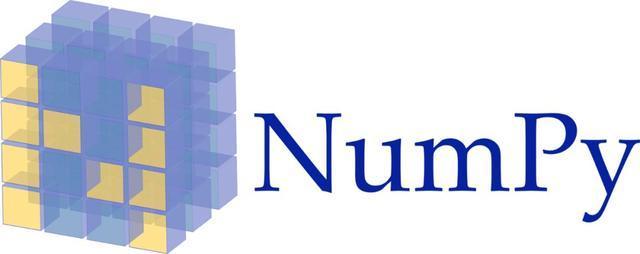Numpy 是用于科学计算的 Python 语言扩展包,通常包含强大的 N 维数组对象、复杂函数、用于整合 C/C++和 Fortran 代码的工具以及有用的线性代数、傅里叶变换和随机数生成能力。
除了上面这些明显的用途,Numpy 还可以用作通用数据的高效多维容器(container),定义任何数据类型。这使得 Numpy 能够实现自身与各种数据库的无缝、快速集成。

6 种 Numpy 函数。
argpartition()
借助于 argpartition(),Numpy 可以找出 N 个最大数值的索引,也会将找到的这些索引输出。然后我们根据需要对数值进行排序。
x = np.array([12, 10, 12, 0, 6, 8, 9, 1, 16, 4, 6, 0])index_val = np.argpartition(x, -4)[-4:]index_valarray([1, 8, 2, 0], dtype=int64)np.sort(x[index_val])array([10, 12, 12, 16])
allclose()
allclose() 用于匹配两个数组,并得到布尔值表示的输出。如果在一个公差范围内(within a tolerance)两个数组不等同,则 allclose() 返回 False。该函数对于检查两个数组是否相似非常有用。
array1 = np.array([0.12,0.17,0.24,0.29])array2 = np.array([0.13,0.19,0.26,0.31])# with a tolerance of 0.1, it should return False:np.allclose(array1,array2,0.1)False# with a tolerance of 0.2, it should return True:np.allclose(array1,array2,0.2)True
clip()
Clip() 使得一个数组中的数值保持在一个区间内。有时,我们需要保证数值在上下限范围内。为此,我们可以借助 Numpy 的 clip() 函数实现该目的。给定一个区间,则区间外的数值被剪切至区间上下限(interval edge)。
x = np.array([3, 17, 14, 23, 2, 2, 6, 8, 1, 2, 16, 0])np.clip(x,2,5)array([3, 5, 5, 5, 2, 2, 5, 5, 2, 2, 5, 2])
extract()
顾名思义,extract() 是在特定条件下从一个数组中提取特定元素。借助于 extract(),我们还可以使用 and 和 or 等条件。
# Random integersarray = np.random.randint(20, size=12)arrayarray([ 0, 1, 8, 19, 16, 18, 10, 11, 2, 13, 14, 3])# Divide by 2 and check if remainder is 1cond = np.mod(array, 2)==1condarray([False, True, False, True, False, False, False, True, False, True, False, True])# Use extract to get the valuesnp.extract(cond, array)array([ 1, 19, 11, 13, 3])# Apply condition on extract directlynp.extract(((array < 3) | (array > 15)), array)array([ 0, 1, 19, 16, 18, 2])
where()
Where() 用于从一个数组中返回满足特定条件的元素。比如,它会返回满足特定条件的数值的索引位置。Where() 与 SQL 中使用的 where condition 类似,如以下示例所示:
y = np.array([1,5,6,8,1,7,3,6,9])# Where y is greater than 5, returns index positionnp.where(y>5)array([2, 3, 5, 7, 8], dtype=int64),)# First will replace the values that match the condition, # second will replace the values that does notnp.where(y>5, "Hit", "Miss")array(['Miss', 'Miss', 'Hit', 'Hit', 'Miss', 'Hit', 'Miss', 'Hit', 'Hit'],dtype='<U4')
percentile()
Percentile() 用于计算特定轴方向上数组元素的第 n 个百分位数。
a = np.array([1,5,6,8,1,7,3,6,9])print("50th Percentile of a, axis = 0 : ", np.percentile(a, 50, axis =0))50th Percentile of a, axis = 0 : 6.0b = np.array([[10, 7, 4], [3, 2, 1]])print("30th Percentile of b, axis = 0 : ", np.percentile(b, 30, axis =0))30th Percentile of b, axis = 0 : [5.1 3.5 1.9]
Pandas 也是一个 Python 包,它提供了快速、灵活以及具有显著表达能力的数据结构,旨在使处理结构化 (表格化、多维、异构) 和时间序列数据变得既简单又直观。

Pandas 适用于以下各类数据:
具有异构类型列的表格数据,如 SQL 表或 Excel 表;
有序和无序 (不一定是固定频率) 的时间序列数据;
带有行/列标签的任意矩阵数据(同构类型或者是异构类型);
其他任意形式的统计数据集。事实上,数据根本不需要标记就可以放入 Pandas 结构中。
Pandas 擅长处理的类型如下所示:
容易处理浮点数据和非浮点数据中的 缺失数据(用 NaN 表示);
大小可调整性: 可以从 DataFrame 或者更高维度的对象中插入或者是删除列;
显式数据可自动对齐: 对象可以显式地对齐至一组标签内,或者用户可以简单地选择忽略标签,使 Series、 DataFrame 等自动对齐数据;
灵活的分组功能,对数据集执行拆分-应用-合并等操作,对数据进行聚合和转换;
简化将数据转换为 DataFrame 对象的过程,而这些数据基本是 Python 和 NumPy 数据结构中不规则、不同索引的数据;基于标签的智能切片、索引以及面向大型数据集的子设定;
更加直观地合并以及连接数据集;
更加灵活地重塑、转置(pivot)数据集;
轴的分级标记 (可能包含多个标记);
具有鲁棒性的 IO 工具,用于从平面文件 (CSV 和 delimited)、 Excel 文件、数据库中加在数据,以及从 HDF5 格式中保存 / 加载数据;
时间序列的特定功能: 数据范围的生成以及频率转换、移动窗口统计、数据移动和滞后等。
read_csv(nrows=n)
大多数人都会犯的一个错误是,在不需要.csv 文件的情况下仍会完整地读取它。如果一个未知的.csv 文件有 10GB,那么读取整个.csv 文件将会非常不明智,不仅要占用大量内存,还会花很多时间。需要做的只是从.csv 文件中导入几行,之后根据需要继续导入。
import ioimport requests# I am using this online data set just to make things easier for you guysurl = "https://raw.github.com/vincentarelbundock/Rdatasets/master/csv/datasets/AirPassengers.csv"s = requests.get(url).content# read only first 10 rowsdf = pd.read_csv(io.StringIO(s.decode('utf-8')),nrows=10 , index_col=0)
map()
map( ) 函数根据相应的输入来映射 Series 的值。用于将一个 Series 中的每个值替换为另一个值,该值可能来自一个函数、也可能来自于一个 dict 或 Series。
# create a dataframedframe = pd.DataFrame(np.random.randn(4, 3), columns=list('bde'), index=['India', 'USA', 'China', 'Russia'])#compute a formatted string from each floating point value in framechangefn = lambda x: '%.2f' % x# Make changes element-wisedframe['d'].map(changefn)
apply()
apply() 允许用户传递函数,并将其应用于 Pandas 序列中的每个值。
# max minus mix lambda fnfn = lambda x: x.max() - x.min()# Apply this on dframe that we've just created abovedframe.apply(fn)
isin()
lsin () 用于过滤数据帧。Isin () 有助于选择特定列中具有特定(或多个)值的行。
# Using the dataframe we created for read_csvfilter1 = df["value"].isin([112]) filter2 = df["time"].isin([1949.000000])df [filter1 & filter2]
copy()
Copy () 函数用于复制 Pandas 对象。当一个数据帧分配给另一个数据帧时,如果对其中一个数据帧进行更改,另一个数据帧的值也将发生更改。为了防止这类问题,可以使用 copy () 函数。
# creating sample series data = pd.Series(['India', 'Pakistan', 'China', 'Mongolia'])# Assigning issue that we facedata1= data# Change a valuedata1[0]='USA'# Also changes value in old dataframedata# To prevent that, we use# creating copy of series new = data.copy()# assigning new values new[1]='Changed value'# printing data print(new) print(data)
select_dtypes()
select_dtypes() 的作用是,基于 dtypes 的列返回数据帧列的一个子集。这个函数的参数可设置为包含所有拥有特定数据类型的列,亦或者设置为排除具有特定数据类型的列。
# We'll use the same dataframe that we used for read_csvframex = df.select_dtypes(include="float64")# Returns only time column
pivot_table( ) 也是 Pandas 中一个非常有用的函数。对 pivot_table( ) 在 excel 中的使用有所了解,那么就非常容易上手了。
# Create a sample dataframeschool = pd.DataFrame({'A': ['Jay', 'Usher', 'Nicky', 'Romero', 'Will'], 'B': ['Masters', 'Graduate', 'Graduate', 'Masters', 'Graduate'], 'C': [26, 22, 20, 23, 24]})# Lets create a pivot table to segregate students based on age and coursetable = pd.pivot_table(school, values ='A', index =['B', 'C'], columns =['B'], aggfunc = np.sum, fill_value="Not Available") table
https://github.com/kunaldhariwal/12-Amazing-Pandas-NumPy-Functions